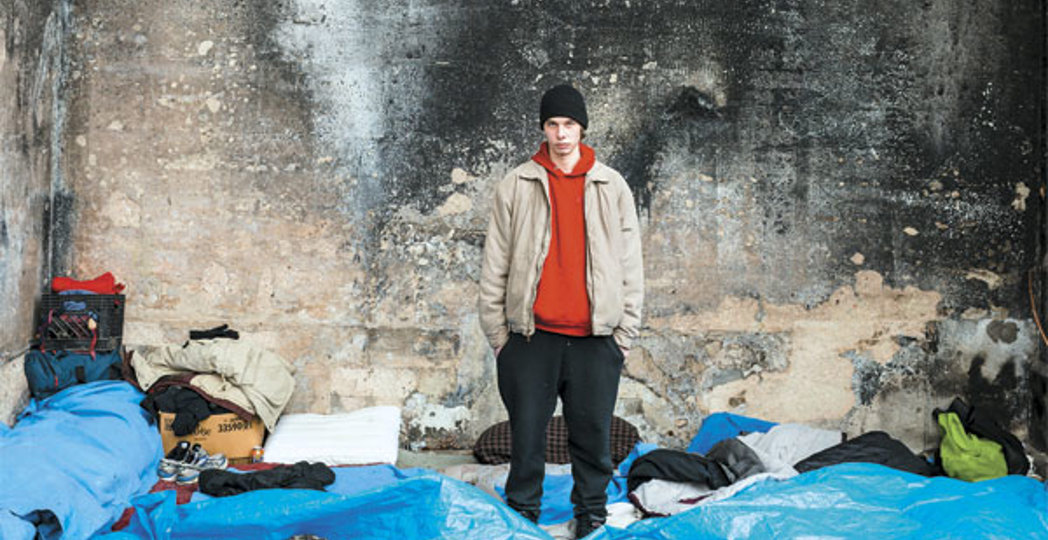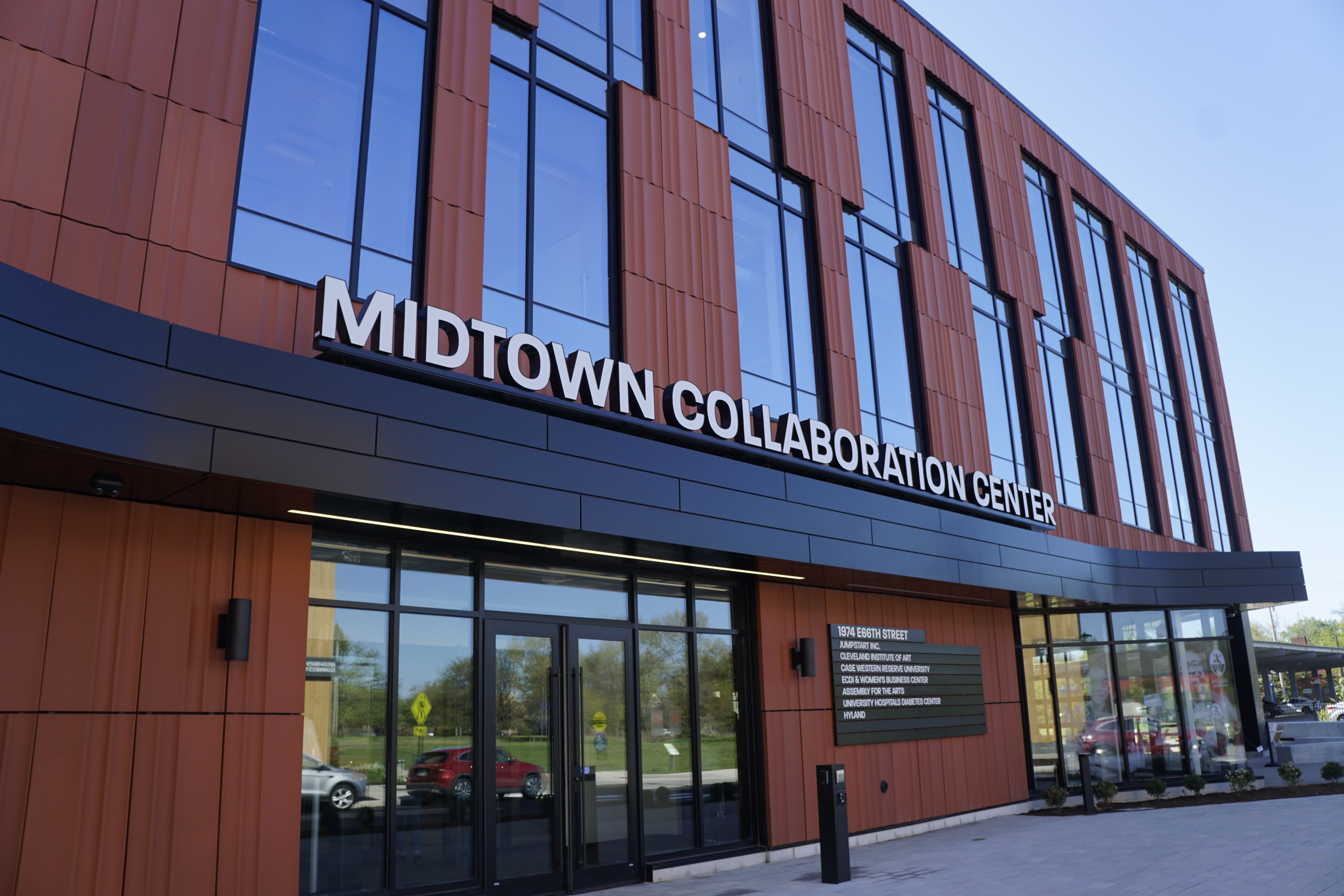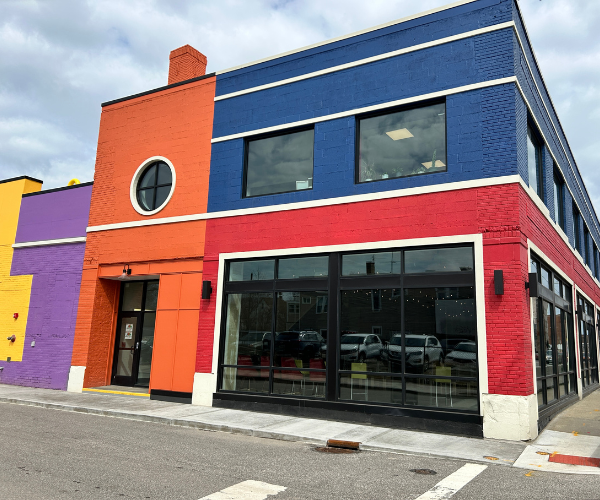The Lost Ones
They’re difficult to identify and even tougher to help. But the number of teens and young adults at-risk and on the street in Northeast Ohio is startlingly high. While the reasons and possible solutions are complex, local groups are uniting for an ambitious effort to end youth homelessness by 2020.
by James Bigley II | Mar. 17, 2016 | 4:00 AM

Angelo Merendino
Daniel Lentine slowly paces the sidewalk with a friend outside St. Malachi Parish. The yellow hood of his sweater is pulled up over his bowed head and hunched shoulders. He's holding tightly to the front of a dark blue winter jacket.
It's just after 1 p.m. on Jan. 26, and although the temperature is beginning to drop, it's still 40 degrees, much warmer than the week before.
"Hi, how are you guys?" asks Karen McHenry in a meek, motherly voice as she walks up wearing a sweater underneath a neon yellow safety vest. She holds a stack of green cards in her right hand.
The program manager for Bellefaire JCB's homeless and missing youth program is one of several people out in the streets today counting the homeless. It's part of a national point-in-time count for the U.S. Department of Housing and Urban Development.
"Would you guys be interested in filling out a survey?" McHenry asks.
Lentine takes a small step back and looks to his friend for guidance. When he doesn't show any interest, Lentine turns back to McHenry.
"I would, but my hands are frozen," he says with a raspy voice, holding his hands up to show that he's wearing black insulated gloves.
McHenry takes out a pen. "You want me to fill it out for you?"
"Sure," Lentine says, after a second's hesitation.
"Do you have stable housing?" she asks.
Lentine pulls on the straps of his backpack and pivots his weight from his left foot to his right. "No," he says, keeping his eyes on the ground.
McHenry relaxes her grip on the pen and looks up at him.
"Where do you stay?" she asks.
He lifts his head to look at her. His face is pale, framed by a patchwork beard. His lips are chapped and peeling from exposure to the elements.
"Under a bridge," he says.
Only 22 years old, Lentine has been sleeping inside a 15-foot-wide alcove under a West Side bridge nearly every night for the last year. He shares the space with his 40-year-old cousin and his cousin's 47-year-old friend.
"Dude, isn't it cold?" asks McHenry.
Lentine cracks a small smile, the light in his eyes betrayed by the dark circles that surround them. "We have a lot of blankets."
•••••
There are more than 20 blankets at the bridge. They're hidden underneath a large blue tarp the trio acquired from a local church. Stacks of clothes, many of which have long gone unwashed, are folded neatly in a single file on the far left side of the space. On a branch less than 20 feet away, a roll of toilet paper hangs for when they need it.
"It's like an apartment," he says. "It's clean. It's warm."
The three function as a family. Every morning they go to St. Malachi for breakfast — a service provided by the church for those in need. Afterward, his cousin's friend holds up a sign by the freeway while Lentine and his cousin ask people for money downtown. On rare occasions, they make enough to afford a room at a downtown hotel, but most of the time they only have enough to get food at Tower City Center before heading back to the bridge for the night.
In the summer, a line of trees hides their camp, which they refer to as the Spot, from the nearby parking lot. During winter, they run the risk of being seen.
Lentine says the police let them stay there as long as they keep the area clean, but its proximity to bars and the possibility of discovery increases their risk for removal or worse — invaders. Earlier in the month, Lentine had his toothbrush, shampoo and deodorant stolen when he left it behind at the Spot.
"It's challenging," he says. "We don't know when someone is going to come under the bridge and attack us or kill us."
He carries an extra blanket in his backpack in case the others get soaked. When it's cold, he spends the day in the tech center in the basement of the Cleveland Public Library to stay warm, searching online for jobs that don't require a high school diploma.
In November, every branch of the Cleveland Public Library became designated safe spaces for children and youth in crisis. The yellow and black diamond-shaped sticker on the doors of every library and more than 500 Greater Cleveland Regional Transit Authority buses indicate that all staff are trained to recognize signs of homelessness and to direct youth in need of shelter and safety if they request it.
But when McHenry asks Lentine if he's tried going to an emergency shelter, he says he doesn't know where to go. He's heard of the men's shelter at 2100 Lakeside Avenue, but he's afraid of staying there.
"They steal your stuff. They jump you — I don't want none of that," says Lentine. "I'm young, so I know they're going to target me."
Lentine fits what many imagine when they think of homelessness. He's a high school dropout and former heroin addict. Although he's been clean for more than a year now, he has exhausted his resources and has nowhere left to go.
He doesn't know his father. His ties with his mother are nearly severed. When he was 7 years old, she was sentenced to three years in the Ohio Reformatory for Women. She was convicted of involuntary manslaughter for giving birth to a baby girl and allegedly suffocating her and concealing the remains inside a trash bag.
Now, Lentine occasionally visits her where she lives on the West Side, but he isn't allowed to move in.
"She don't treat me like I'm her son," he says. "When we hang out, she tells me when I have to leave."
•••••
Lentine is just one of more than 550,000 individuals under the age of 24 who experience homelessness for longer than a week each year in the United States, according to the National Alliance to End Homelessness.
Nationally and in Ohio, homelessness has been on the decline since 2010 when President Barack Obama launched the nation's first-ever comprehensive strategy to prevent and end homelessness. In the latest HUD figures, Ohio showed an 11 percent decline in homelessness since 2010 with vast improvements in the number of homeless families, homeless veterans and chronic homelessness.
So last year, with homelessness declining among other demographics, HUD began asking shelter systems to identify and track 18- to 24-year-olds separately from the population in an effort to improve solutions for them. HUD's goal is to end all homelessness by 2020.
But local homeless advocates believe HUD's numbers don't offer a full picture. Brian Davis, executive director of the Northeast Ohio Coalition for the Homeless, estimates that 23,000 people were homeless in Cuyahoga County in 2014 — or almost double the HUD figure for the entire state that year. He estimates one in 10 people living in poverty in the county experienced homelessness in 2014.
Cities like Cleveland with a high rate of poverty tend to have more people doubled-up temporarily with friends and extended family, returning from prison or staying intermittently in motels, flophouses or abandoned buildings, he says.
In addition, he says, a reduction in local shelter beds and limited rental assistance means more people are living outside the federally funded housing system and thus more difficult to be counted.
This is especially true for at-risk or homeless teens and young adults.
They are in critical developmental stages of their lives, many caught in transition between childhood and adulthood, say youth advocates. They require more support, because they've either been neglected or don't have the experience to be self-sufficient. They're also frequently transient, hidden from the public eye and difficult to help.
In 2015, for example, the Cleveland/Cuyahoga County Office of Homeless Services reported that emergency shelters served 521 18- to 24-year-old individuals. Eighty-eight percent of those stayed multiple times with an average stay of 44 days.
"We're not sure if this is the tip of the iceberg or the entire iceberg," says Ruth Gillett, program director of the Office of Homeless Services.
To address the problem, more than 60 organizations and public agencies, many of which have been working to combat various aspects of homelessness for years, have come together for an initiative known as A Place 4 Me. It's goal? Eliminate youth homelessness in Cuyahoga County by the end of the decade.
"I think ending youth homelessness is an audacious goal," says Kate Lodge, project director of A Place 4 Me at the YWCA of Greater Cleveland. "But really, for any kid who shows up, we have a way in our community of addressing that young person and some resources."
The plan, which has been in development over the last two years, hopes to establish a safety net of services and create a pipeline to permanent housing for anyone 14 to 24 who is unaccompanied by a parent or legal guardian and lacks a fixed, regular and adequate nighttime residence.
This coordinated effort is promising. But implementation is complex when you consider that even the agencies charged with addressing the issue sometimes don't agree on what it actually means to be homeless.
The problem begins in HUD's definition. It considers a person homeless if he is staying in an emergency shelter, transitional housing, a motel paid for by a government or charitable organization, or in a place not meant for human habitation. An individual at-risk of homelessness can receive support from HUD-funded programs if it can be proven the person will lose housing within 14 days and has no other resources to obtain permanent housing.
Using those definitions, Cuyahoga County reported 6,234 people within its emergency shelter system last year and 1,550 people in transitional living programs. But those numbers may be misleading — for two reasons.
First, shelters are often a path to transitional living programs, which offer housing and services for up to 24 months. Yet, the shelter system and transitional living programs each report individually to the office of homeless services, causing the potential for overlap in the data.
Additionally, the county numbers don't include people served by victim service providers such as the Domestic Violence and Child Advocacy Center or those sheltered by private organizations such as the City Mission, which served nearly 1,400 men, women and children in 2015.
There are many blind spots in the system, but perhaps the greatest is at-risk youth.
"Until the feds change the definition of homelessness, it's really hard to fit youth into our system," says Davis.
But with limited federal funding, simply expanding the definition of homelessness may do little good. "Making someone •homeless' is not a benefit to them because there are no resources for all those people," says Gillett.
That's why A Place 4 Me is important. The initiative doesn't subscribe to one definition or one funding stream. So over the next few years, the 60 organizations and the office of homeless services will implement a single standardized process for engaging youth so that the shelter system doesn't have to be the only solution.
Housing options will include prioritized public housing and a creation of a vetted network of landlords willing to rent to at-risk youth. And if along the way, a youth needs supportive services such as rental assistance, food, employment opportunities, counseling and mentorship programs, those will be made available.
"It's not like we're San Francisco," says Lodge. "It's a manageable number that our community can come around together. We got this."
•••••
Lentine has agreed to meet McHenry at St. Malachi in an attempt to place him at the Volunteers of America shelter on Walton Avenue. Two years ago, the shelter switched from serving men of all ages to strictly 18- to 24-year-old males. But first, he must fill out forms and answer questions at the William M. Bishop Cosgrove Center on Superior Avenue.
He shows up around 11:45 a.m. wearing the same clothes as the day before. This time he has a different friend with him. The man, in his mid-30s, has a thick beard framing a limp cigarette clamped between his teeth.
He says he's homeless and curious about his options. He wants to come with Lentine while he gets processed for entry into the Volunteers of America shelter. McHenry and Bill Kelly, Bellefaire JCB'S street outreach coordinator, agree to give them both a ride.
Once outside the building, Lentine's friend stops and changes his mind. He's going to wait outside.
"All right, I ain't going to be that long," Lentine says.
On the second floor, a desk sits next to a metal detector. Lentine takes a clipboard with a sign-in sheet and sighs heavily, slumping into the chair. It asks for general information: name, birthday, Social Security number, medical and mental health history.
"How long does this take?" he asks.
"It's not going to take long," says McHenry. "They'll go over all your options, and you can decide which ones are for you."
Chronically homeless applicants with mental health issues, a disability or suffering from addictive behaviors have expanded opportunities for permanent supportive housing — an apartment that comes with services and treatment programs such as rehabilitation, counseling and life skills training.
After a couple of minutes, McHenry senses Lentine's anxiety. His eyes dart from the clipboard to the nearby window where he can see his friend standing outside smoking. She offers to go downstairs to convince his friend to come inside or perhaps give him a Subway gift card so he can wait somewhere warm.
"Don't give him the gift card or he won't come up," says Lentine. "Tell him I need to talk to him."
But he refuses.
"He's not coming in," she says. "I'll go give him the gift card so he can go."
"Just wait," Lentine says, a sense of urgency building in his voice. "Wait until we're done because I gotta go down to talk to him."
"Well, it's going to be a little bit," she says. "You don't want him standing outside."
"He's going to wait for me," says Lentine, shaking his head. "He's telling me this VOA is like a prison."
"It's not a prison," she says. "You can come and go as you please."
He asks McHenry about some of the other options available to him. She starts to tell him about Job Corps, an education and training program that helps 16- to 24-year-olds acquire their high school diploma while receiving vocational training in a field of their choice. Before they can finish, Lentine's friend comes inside.
"How long are you going to be?" he asks, sitting down next to Lentine.
"Not long," says Lentine, gritting his teeth. "Just sit down and be warm instead of being in the cold."
McHenry reaches for the clipboard.
"You want to fill out a sheet?" she asks.
"Just do it," Lentine urges.
His friend doesn't budge. When the doors open and Lentine is called back, he leaves his backpack in the waiting room with his friend.
"Be right upfront," Lentine tells him. "Don't go nowhere."
When the doors close behind them, they start walking down the long hall toward the office on the far left side.
"I just don't like this kind of stuff," Lentine says.
"You're not locked in anywhere, buddy," McHenry says.
"I know," says Lentine. "But this looks like a jail facility."
McHenry takes a deep breath and walks a little closer to Lentine.
"I know, you're really nervous," she says. "I can tell. Just keep breathing."
When they reach the room at the far end, it's another waiting area with stacks of magazines on a table in the corner, a TV hanging on the wall. Lentine slumps into a chair and his right leg begins to shake, the heel of his boot tapping rhythmically on the tiled floor.
In minutes, he's taken into a small room with a desk and a computer. Lentine asks one more time how long the process will take.
"About 20 to 25 minutes," says the intake specialist. "We definitely like to know what's going on to find the best way to help you. Do you have an ID?"
He doesn't. Lentine left it behind at the Spot.
So he asks Lentine for his name, his birthdate and his Social Security number.
"Are we able to do this half now, half later?" Lentine asks, perched on the edge of his chair. "I've got somewhere important to be."
"I can't really just stop in the middle of intake," the specialist says. "Are you going to come back here by yourself later on?"
"Yeah, I'm just going to Prospect," says Lentine, smiling nervously. Lentine says he needs to meet a friend who's supposed to give him money. He doesn't want to miss out on the opportunity or he'll have to spend more time panhandling on the street.
A few seconds later, Lentine is walking out of the office, bypassing McHenry and Kelly. They've been inside for less than 20 minutes. By the time McHenry goes into the hall, Lentine is already gone.
"A lot of times, they'll leave and say they're coming back," says Kelly. "They usually don't."
•••••
The shelters are grossly overcrowded.
Yet for many homeless, the path to something better begins there, in a process known as coordinated intake. A screening determines whether they need services such as medical care, food stamps or child care. The Cleveland Mediation Center tries to find friends or relatives they can stay with rather than sending them to an emergency shelter.
But if no one can be found, they're sent to a shelter or one of four overflow locations, such as St. Paul's Community Church on West 45th Street, until a bed is open.
Once in a shelter, they can then be referred to other housing programs. But getting far enough along in the shelter system to be placed in housing can be a difficult task.
"The homeless system is really a housing crisis response system," says Gillett.
For example, Norma Herr, a women's shelter on Payne Avenue, has 140 permanent beds. On average it hosts 180 women each night and sometimes takes in more than 200 women and children, lining them up on green plastic mats from wall to wall in the shelter's cafeteria.
Even the men's shelter at 2100 Lakeside Avenue reports serving 3,689 people last year, with averages close to 400 every night.
"If you don't have resources to offer people to leave shelter, they're going to stay longer," says Gillett. "They're going to stay in shelter until they can find a job, until they can save money and until they can move out."
So HUD is emphasizing a method known as rapid rehousing, which places a family or individual into an apartment within 45 days of them entering the shelter system. Rental assistance is available for a few months with the hopes of the family or individual taking over the lease on their own. Cuyahoga County has been offering rapid rehousing to families since 2010 and has plans to expand the program to individuals, placing a priority on young adults.
Data shows that rapid rehousing saves about $5,500 per positive permanent housing placement in Cuyahoga County, while reducing the average length of stay in the shelter system.
"If someone can get back into housing," says Gillett, "they have a better chance of getting back on their feet more quickly, re-engaging in their community and their life."
But with limited funding, cuts may be needed elsewhere to pay for the shift in focus.
When money was reallocated from the Cleveland Mediation Center's diversion program, it resulted in 11 percent fewer families being guided away from the shelter system in 2015, according to executive director Kathleen Jackson. Thus more families ended up in the shelters.
Funding changes also cut 82 transitional beds from the county's continuum of care as of Feb. 1. Homeless services ceased funding the 26-bed transitional living program for 18- to 24-year-olds at the Volunteers of America shelter, leaving it with only eight transitional beds paid for with a grant from the Ohio Development Services Agency.
In 2015, the county applied to reallocate $708,000 from its transitional living programs to fund rapid rehousing. (It also applied for an additional $1.2 million in federal money to expand rapid rehousing for families and individuals.)
"You're going to have this backup of people," says Davis, "because you don't have a place to keep them while they're waiting when you close shelter beds."
So even if Lentine had been placed at the VOA's transitional living program, he likely would have lost his bed seven days later — possibly forcing him into the men's shelter at 2100 Lakeside or back to the bridge.
"We can't rely on one strategy to reduce the number of youth who are falling through the cracks," warns Davis.
That's why so many organizations are collaborating under A Place 4 Me. "The energy has come forth," says Lodge. "Every system has to pony up and do what they can."
•••••
Nineteen-year-old Michael Clarke* leans forward in his chair and never once breaks eye contact while he talks about selling drugs and how he learned the tricks of the trade from his extended family.
He speaks about it in a way someone might reminisce over long-ago stories of embarrassment — with certain admiration and a measured distance.
"If I needed money, I would go sell drugs," he says. "If I wanted something and I didn't have money, I would steal it. It didn't bother me."
He smiles nervously while talking about fighting other kids on the street.
"If I got beat, not only would I lose my reputation, but I would go home and get my ass kicked by my cousins and my ass kicked by my uncles because that was an insult to the family," he says.
If not for the slight shift in tone during his explanation, it would be easy to mistake his delivery for arrogance or callousness. "We can't tell people most of our stories," he says, "because of the stuff that we've done and the way we had to be brought up to survive."
Luckily his godfather offered an alternative — he would pay the teen more than $20 an hour to do landscaping if he agreed to give up criminal activity and take school more seriously.
When he turned things around and started making more money, Clarke says tensions escalated at home. His mother expected him to contribute toward finances in the house.
"Once you start realizing that your mother is just using people," he says, "you really start to get angry."
He acted out, breaking rules and getting into daily arguments with her. In October 2012, he says his mother kicked him out of the house — the first of a cycle that left him homeless for two to three days at a time.
He didn't want to get friends involved and had nowhere to go, so Clarke slept in bus stations overnight before heading to school in the morning. Over the course of a year, his bouts of homelessness increased up to a week at a time.
"Anywhere you could go that would be a roof over your head and three solid walls — bus stations, Rapid stations, bus stops — that's where you slept," he says. "A week later, I would get a text, •Come home or I'm calling the cops.' And in another month or two, we'd go at it again."
When the family moved in the fall of 2013, tensions subsided. Clarke was doing well in all of his classes at a new Cleveland Metropolitan School District school and had enrolled in an ROTC program. He was also making a concerted effort to get along with his family. He was in a new relationship with a girl who played softball at a large park not too far from his school.
But in February 2014, Clarke says he got kicked out again.
This time, it was for a few weeks in the middle of winter. He remembered the softball field, the public pavilions and bathrooms. "[The park] was my safe haven," he says.
The park gates closed at 11 p.m., leaving it completely isolated after dark. Clarke waited until then and walked along a hiking trail to a spot where he could survey the entire property. In the pavilion, exposed electrical outlets allowed him to charge his phone when necessary but it didn't provide much shelter.
"If you got lucky and they left the bathrooms unlocked, you could just go chill in the bathrooms," says Clarke. "It was dark as hell, and the lights didn't turn on, but it kept you out of the cold."
In the bathroom, he'd use a knife he kept for protection and cut toilet paper rolls out of their dispensers so he could light small fires in the park's grills. But the restrooms were locked more often than he had hoped. Instead, he spent a majority of his nights sleeping inside a plastic slide on the playground.
"I would sleep for like an hour-and-a-half, and then I would wake up," he says. "I would start running around, doing push-ups, jog around the course a couple of times to get my blood flowing. Once your blood is flowing, you warm up."
At 6 a.m., the sounds of the groundskeepers' vehicles would awaken him and he'd walk to school. There, he would wash up in the bathroom sink. Running on little to no sleep, he faced a full day of classes. He lingered in the building until he'd have to leave and head back to the park for another night.
"Kids in my situation — we go to school and it's heat, it's a meal, it's people to interact with and get stuff off of your chest," Clarke says. "Once school is out, we're back on the street. We're not going home to anyone. We have no one."
As Clarke spent more nights at the park each month, his attention and grades started to slip. He'd often get kicked out of the house on the weekends and not have his uniform for school. Teachers started to notice. To avoid confrontation, he'd go on weekend trips with the ROTC program. But when Monday arrived, he'd be back at the park for shelter and without his school uniform.
Out of frustration and without support, he turned to some of his teachers.
"They were my coping mechanism," says Clarke. "I would always tell them, •I don't want you to tell no one, I don't want no one's pity, I don't want you to feel bad. I'll get through this. It's how I've always been. I promise you I'll be fine, just don't make a big deal about it.' "
Clarke says his teachers kept his secret. In an effort to provide him with extra support, they allowed him to spend additional time in their classrooms, offered him mentorship, and tried to provide information for services that might help him if he chose to utilize them.
"There's not a lot available for a minor who's homeless other than going through the [county]," says one of Clarke's teachers. "They're not interested in that because they're already having a tough time in their home life. Trying to be integrated as a foster kid in someone else's home is really not something they're interested in doing."
In May 2014, Clarke says his mother called the police and reported him missing for 24 hours even though he had been spending every night at the park for three weeks. When the police came to school to question him, he told them his side of the story. The next day, a social worker from the Cuyahoga County Division of Children and Family Services contacted Clarke's mother and met with him during school. Afraid of what would happen, Clarke didn't return home until later that evening. When he arrived, the doors were locked.
"I pounded on the door for over a half-hour, and no one opened the door," he says. So he returned to the park.
A couple days later, children and family services held a mediation review to go over Clarke's case. He says his mother told the county that he was being unruly.
"Out of rage, I told them if they made me go back to the house, I would take my life," Clarke says.
He says the statement resulted in him being placed in a residential program for seven days for further evaluation. When he was released, he was only three months away from turning 18.
"Either I was going to get her to lock me up again, or she was going to get a judge to say I was unruly and I'd be stuck in her house," he says. "So I left."
He ran away to South Carolina, bouncing from house to house in an effort to lay low. When he turned 18, he returned to Ohio and cut all legal ties with his mother. He moved in with his grandmother, who allowed him to stay now that he was of legal age. He slept on a pullout mattress in his cousin's bedroom and paid $200 a month in rent.
When he began his senior year in August 2014, Clarke was in need of help. He was unable to work while attending school full time.
He struggled to afford food and lacked everyday resources like a winter coat and boots. His principal recognized he was in need of additional support and introduced him to Amy Lewis, a life skills coach from the Cleveland Metropolitan School District's Project Act program.
"It's very hard for people to understand that children are involved in homelessness," says Project Act director, Marcia Zashin. "When people think of homelessness, they think of the man on the street with the little brown bag and the bottle of booze [•] or the veteran who has no place to go, but they never think about the kids who are homeless."
Project Act is a districtwide initiative tha
Trending
-
1
-
2
-
3
-
4
-
5










